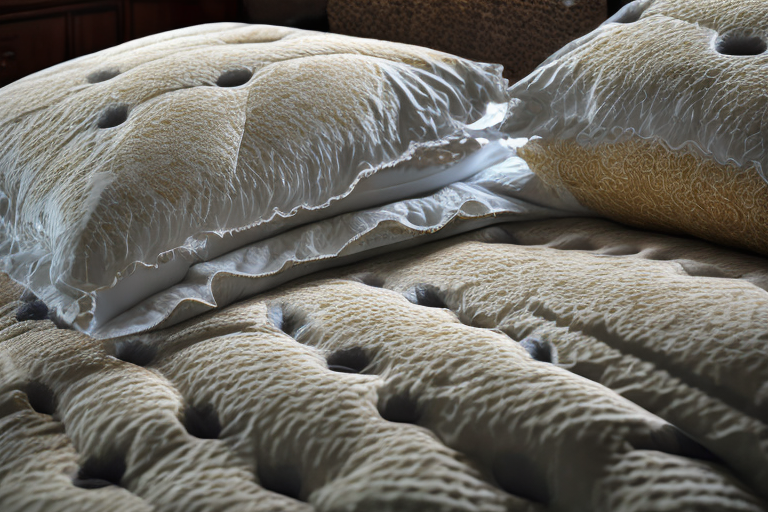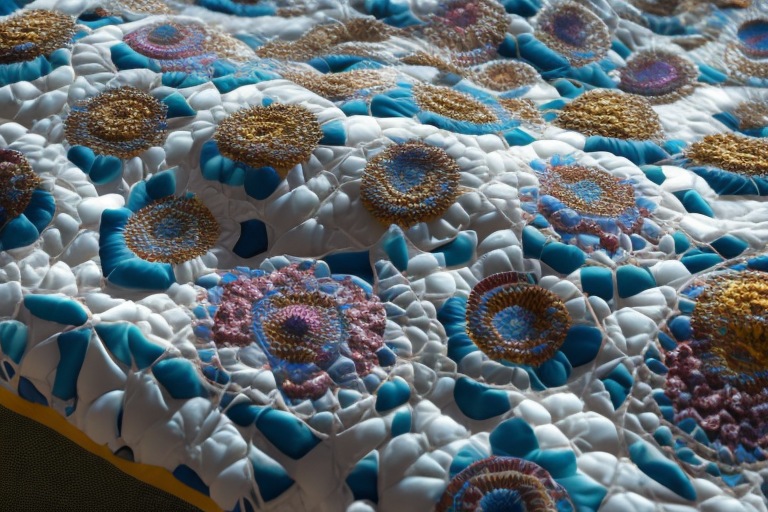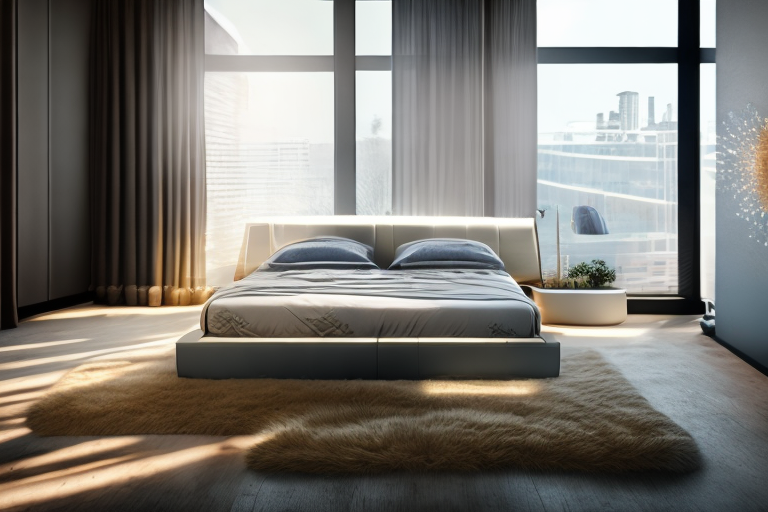Do you love the fluffy warmth of down comforters but find the crinkling noises they make disturbing? You’re not alone. Many down comforter owners wonder what causes that audible rustling sound and if there’s anything that can be done about it.
In this beginner’s guide, we’ll explore the reasons behind the crinkliness of down comforters. We’ll look at the materials used, construction methods, care recommendations, and other factors that contribute to (or reduce) noise levels. We’ll also overview different types of down comforters, useful features for sleep quality, health considerations, and more.
Whether you’re trying to troubleshoot an existing noisy down comforter or looking to choose a new one, you’ll find all the information you need here to understand the crinkle and make the best decision for your needs.
Why Are Down Comforters Crinkly?
The crinkly nature of down comforters stems from two main components:
- The lightweight, paper-thin outer fabric: Popular fabrics like cambric cotton and batiste have a lightweight, gauzy texture that emits a rustling sound when disturbed.
- The down filling: The individual feathers and down clusters shift around inside the comforter with body movement or compression, creating an audible crinkling noise.
Other factors like fabric weave, thread count, construction quality, warmth level, care practices, and more can also impact noise levels.
Down Comforter Fabrics
Let’s take a closer look at some of the common outer fabrics used for down comforters and why they tend to be extra crinkly:
Cambric Cotton
- Pure cotton with a paper-thin, gauzy texture
- Breathable and lightweight
- The more threadbare texture leads to extra crinkling noises
Batiste
- Lightweight plain woven fabric
- Made from cotton, wool, polyester, or blend
- Distinguished by its fine yarns and loose weave
- Extremely supple and prone to wrinkling/crinkling
The table below displays how lower thread counts in these down comforter fabrics allow more air pockets for insulation, but also increase fabric thinness/crinkliness:
| Fabric | Typical Thread Count |
|---|---|
| Cambric Cotton | 180-200 |
| Batiste | 120-140 |
The Down Fill

The fill power and quality of the down also impacts noise levels. Goose down and duck down have unique acoustic properties:
- Goose down clusters tend to be larger and springier, with more trapped air. This allows for extra expansion when disturbed, increasing sound.
- The smaller duck down clusters don’t expand as vigorously, reducing some noise.
See the table below for a breakdown:
| Fill Material | Noise Level | Fluffiness | Breathability | Cost |
|---|---|---|---|---|
| Goose Down | High | Excellent | Excellent | $$$ |
| Duck Down | Moderate | Very Good | Very Good | $$ |
| Down Alternative | Low/None | Good | Very Good | $ |
Synthetic fills like polyester and microfiber are non-allergenic options that don’t make any crinkling noises. However, they don’t offer the unmatched warmth-to-weight ratio of premium goose down.
Down Comforter Construction
The steps used to construct the down comforter also influence noise:
Tightly Woven Fabric
Cheaper fabrics often have loose, irregular weaves. This allows tiny down particles to poke through making crinkling worse over time. Tightly woven, downproof fabrics contain the fill properly to minimize crinkling friction.
Duvet Casing
A good casing not only contains the fill, but also influences noise. Look for cases made from soft, breathable sateen cotton in a tight 300-500 thread count. Avoid cheap polyester casing that can be loud and amplify rustling.
Secure Ends
Corner loops or ties secure the comforter ends, preventing the down from shifting to the sides. This helps maintain an even distribution for less noise.
Care & Cleaning
Follow these care tips to reduce comforter crinkling over time:
- Avoid excessive drying times – Over drying causes the feathers to over expand and break
- Low heat drying – High heat drying can damage down and increase crinkliness
- Tennis balls – Add 2 clean tennis balls to the dryer to fluff down and break up clumps
- Periodic airing – Air out the comforter to allow trapped moisture to dissipate
Key Features for Sleep Comfort
Look for the below features when choosing a down comforter to ensure optimal temperature regulation for sleep:
Breathability
An overly insulated comforter leads to sweating and overheating. Prioritize breathable comforters with moisture wicking fabrics.
Lightweight Warmth
3-season comforters with 550-650 fill down offer breathability for year-round use.
Cooling Features
Some comforters have cooling gels or temperature regulating smart fabrics woven into one side for hot sleepers. These can reduce noise related to moving around from overheating.
Health Considerations
For those sensitive to down, hypoallergenic down alternatives like PrimaLoft are excellent non-allergenic, odorless options.
Responsibly sourced down certified under the Responsible Down Standard (RDS) also ensures purified down free from hazardous contaminants.
Environmental & Ethical Factors
Look for down comforters certified under the Global Recycled Standard (GRS). This validates environmentally friendly production such as recycled packaging materials.
The Comforter Experience
Beyond keeping us warm, down comforters appeal to our senses:
Luxurious Plushness
The body-contouring “sinking in” sensation of a fluffy down encasement triggers natural relaxation.
Soothing Sound
The gentle rustling tug of war between crisp outer fabric and billowy down creates white noise that some find sleep-inducing.
Cloud-Like Aesthetic
Mimicking the look of floating cumulus clouds, down comforters create a dream-like hygge heaven environment.
Down Comforter Varieties

Here is an overview of a few common types:
| Comforter | Description | Noise Level | Price |
|---|---|---|---|
| Down Duvet Insert | Insert only with corner ties, no cover included | High | $$$ |
| Baffle Box Down Comforter | Sewn through anchor bands to prevent shifting | Moderate-High | $$$ |
| Lightweight Down Comforter | 300-350 fill down, ideal for hot sleepers | Moderate | $$ |
| Down Alternative Comforter | Polyester microfiber filling with down-like feel | None/Very Little | $ |
| Responsibly Sourced Down Comforter | Certified RDS goose down, GRS approved production | High | $$$ |
| Egyptian Cotton Covered Down | 400 thread count sateen cotton cover | High | $$$$ |
The amount you spend often comes down to:
- Fill power: Measured in cubic inches per ounce, higher numbers like 700-900+ indicate warmer, higher quality down and thus, a higher price tag.
- Cover fabric: Luxury extra-long staple fabrics like Egyptian cotton or Alpaca wool cost more while also reducing noise.
- Workmanship: Handmade construction from family-owned European cottages can drive up pricing while ensuring reliable quality.
Technological Innovations
While crinkling is inherent to down bedding, some new technologies help reduce noise:
Sound Insulation Mesh Liners
Ultra-fine sound damping membranes integrated into duvet covers absorb friction noise.
Microbead Alternatives
Innovative synthetic fills like Sorona offer down-like benefits like warmth without the shifting.
As fabric and insulation technologies continue advancing, expect to see future improvements reducing crinkling in warmth-optimized bedding.
Buying Considerations
Follow this advice for stress-free down comforter purchasing:
- Read Reviews: Look for customer feedback specifically addressing noise levels and overall quality satisfaction.
- Check Warranties: Many reputable brands offer generous 10 or even lifetime warranties against defects.
- Order Swatches: If fabric crinkliness is a top concern, order free fabric swatches first to assess noise levels.
The minor upfront investment – around $250-$350 for a quality queen down comforter – pays off exponentially in years of blissful sleep comfort.
In Closing
The crinkly wonder of down comforters stems from the same delicate lightweight construction allowing for magical warmth and billowy softness. While natural and synthetic down alternatives eliminate noise, none replicate the cloud-like comfort of premium white goose down.
Optimizing thread count, weave tightness, and overall construction goes a long way to reduce crinkling levels. Additionally, new sound-absorbing technologies offer promising noise alleviating enhancements expected to expand across future bedding options.
When chosen and cared for properly, down comforters reward us with a little piece of heaven welcoming us under the covers each night. For many, that sensuous invasion of feathers shuffling around you is a soothing semantic lullaby promising restful slumber ahead.
Frequently Asked Questions
What is the average price for a down comforter?
The average down comforter costs between $200-$500 depending on size, materials, and quality. Many premium options with high fill power down and fine fabrics like Egyptian cotton can cost upwards of $1000. However, good quality introductory down comforters start around $150-$250.
How do I make my down comforter less crinkly?
Using a tight duvet casing made from soft, high thread count sateen cotton can help reduce crinkling noises. Additionally, adding lightweight comforter covers, using wool dryer balls instead of tennis balls, and air drying instead of machine drying can minimize noise over time.
What thread count is best for down comforters?
Look for a cotton cover with a 300-500 thread count. This allows enough air pockets for warmth while having a tighter weave style that contains feathers. Specialty extra-long staple cotton woven in damask or jacquard style 200-400 thread counts also make durable, smooth covers.
How often should you replace a down comforter?
With proper care, a quality down comforter will last over a decade. Look for signs of deterioration like significant clumping, poking feathers, flattened sections, or yellowed fabric to determine when to replace. Most comforters come with a manufacturer’s warranty against defects for added security.
How do I make my down comforter fluffier?
Regularly fluff and redistribute the filling by gently massaging the comforter surface using your hands. Air dry instead of machine drying when possible. Adding two clean tennis balls to the dryer will also help break up clumps without damage.
Is goose or duck down better?
Goose down offers superior insulation due to larger, springier clusters that expand more for added loft and durability over time. The smaller duck down clusters don’t expand as much. However, duck down comes at a lower price point while still providing excellent warmth for the cost.
What’s warmer: down alternative or real down?
While synthetic fills mimic the feel of real down, premium white goose down offers the best warmth-to-weight ratio and overall comfort. However, down alternatives cost less and work better for allergy sufferers. Responsibly-sourced down certified under RDS offers a nice compromise.








